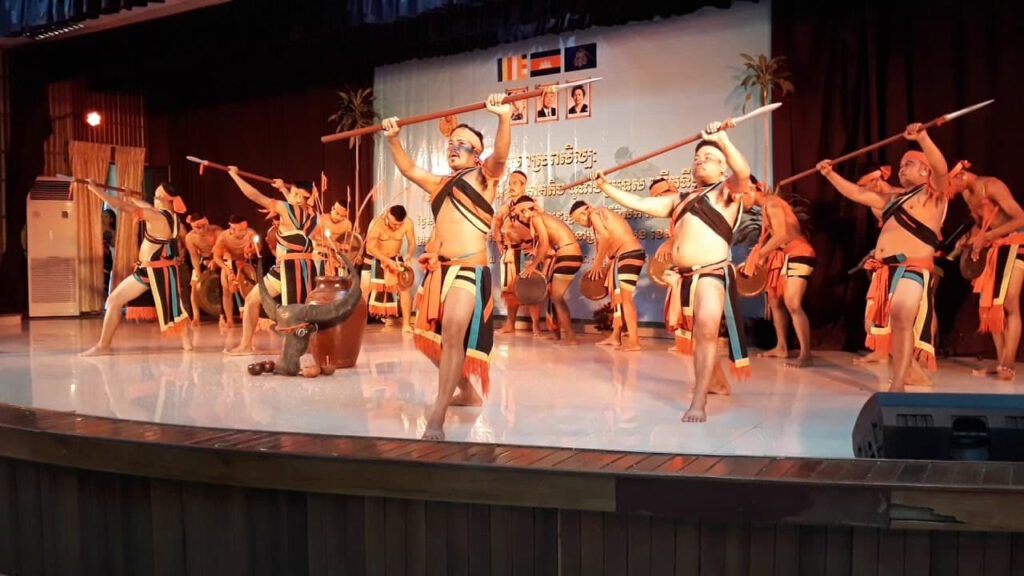ព្រះរាជាណាចក្រកម្ពុជា សម្បូណ៌ទៅដោយជនជាតិដើមភាគតិច ដែលរស់នៅក្នុងតំបន់ខ្ពង់រាបតាមដងភ្នំក្រវ៉ាញ ភ្នំឱរ៉ាល់ ភ្នំដងរែក និងតំបន់ភ្នំផ្នែកទិសឦសានក្នុងខេត្តមណ្ឌលគិរីនិងរតនគិរី។ ជនជាតិដើមភាគតិចទាំងនេះ មានស្អូច ស្ទៀង ក្រោល សម្រែ រ៉ាអុង (រអួង) ព័រ សួយ គួយ គ្រឹង ទំពួន លុន ចារ៉ាយ ព្រៅ កាចក់ កាវ៉ែត ថ្មូន ស្មឹល ជង អាណុង រ៉ូដេរ ខា និងព្នង។ល។
ជនជាតិដើមភាគតិចមានវប្បធម៌ពិសេសរៀងៗខ្លួនប្រចាំក្រុមនិងជាតិសាសន៍របស់ខ្លួន រួមទាំងតន្ត្រីនិងរបាំ។ ឧបករណ៍តន្ត្រីរបស់គេ មាន៖ ព្លយ ម៉ិម ហ្កងណាក់ (រនាតបំពង់ឫស្សីតូចៗ) កាណី (ទ្រឃ្លោក) ប្រក (កូតឬដេញក៏បាន) ហ្កងទីង ហ្កងរីង (កេះឬដេញ) ហ្កង-ប (កំណាត់ឫស្សីវាយផ្ទប់នឹងដីឲ្យឮសូរ) ដ្រួ (ខ្លុយ) ហេតហូត (បំពង់ឫស្សីតូចៗចងភ្ជាប់គ្នាផ្លុំជាសូរ) ប៊ុមប៊ុក (ឫស្សីទះ) ជីងរៀង (ចាប៉ីឃ្លោក) គងញីនិងគងឈ្មោល ព្រមទាំងវង់គង៣ផ្លែ ៥ផ្លែ ៧ផ្លែ ១២និង១៣ផ្លែ។ ឯរបាំក៏មានច្រើន ដូចជារបាំយុវ័នរួមសាមគ្គី របាំប៊ុនហ៊ា របាំរាំវង់ភូមិថ្មី របាំសែនភូមិ របាំភោគផល និងរបាំកាប់ក្របី(ផឹកស្រា) ជាដើម។
នៅក្នុងចំណោមជនជាតិដើមភាគតិចនៅភូមិភាគឦសាននៃប្រទេសកម្ពុជា គេតែងប្រារព្ធធ្វើពិធីកាប់ក្របីដើម្បីថ្វាយជូនទៅព្រលឹងអារក្ខអ្នកតាក្នុងជំនឿអរូបីរបស់គេ។ នៅក្នុងពិធីដែលគេរៀបចំឡើង អ្នកភូមិមានចាស់មានក្មេងវាយគងនិងរាំច្រៀងជាក្រុម។

ជាពិសេសនៅពេលច្រូតកាត់រួចហើយ នៅក្នុងទំនៀមទម្លាប់របស់គេ អ្នកភូមិរៀបចំធ្វើពិធីកាប់ក្របី ដើម្បីថ្វាយកតញ្ញូតាធម៌ចំពោះព្រលឹងអារក្ខអ្នកតានិងវត្ថុស័ក្តិសិទ្ធអ្នកថែរក្សាគេ និងអបអរសាទរចំពោះផលិតផលសម្បូណ៌ហូរហៀរដែលគេទើបតែនឹងច្រូតកាត់រួច។ នៅក្នុងឱកាសជប់លៀងពេលថ្ងៃឬល្ងាច គេផឹកស្រាពាងបិទនិងរាំលេងកម្សាន្ត ដើម្បីឱ្យមានសុខដុមភាពជាមួយនឹងព្រលឹងអារុក្ខអារក្ខអ្នកតានិងវត្ថុស័ក្តិសិទ្ធដែលថែរក្សាគេ។ នៅពេលនេះដែរ ដែលគេបូជាក្របី ហៅថា «ពិធីកាប់ក្របី»។
របាំកាប់ក្របី ឬ របាំកាប់ក្របីផឹងស្រា រាំដោយអ្នករាំសុទ្ធតែប្រុស កំដរដោយវង់តន្ត្រីគង១២ឬ១៣ផ្លែ ដែលបង្ហាញនូវភាពមាំមួន រឹងប៉ឹង កម្លាំងខ្លាំងក្លា និងឥទ្ធិពលទៅតាមចលនានៃការបរបាញ់ សកម្មភាពប្រមាញ់សត្វ ដោយទន្ទ្រាំជើងខ្លាំងៗទៅលើដី និងផឹកស្រាពាង ទៅតាមចង្វាក់នៃសូរវង់គង។ នាបុរាណកាល នៅក្នុងអំឡុងនៃពិធីនេះ បន្ទាប់ពីពិធីបានប្រារព្ធធ្វើរួចចប់សព្វគ្រប់ហើយ គេក៏នាំគ្នាចេញទៅបរបាញ់សត្វ។
ក្រៅពីអត្ថន័យខ្លឹមសាររក្សាទំនៀមទម្លាប់ប្រពៃណីនិងជំនឿរបស់គេ របាំកាប់ក្របីផឹកស្រា លាតត្រដាងពីជីវិតប្រចាំថ្ងៃរបស់ជនជាតិដើមភាគតិចដែលបង្កប់នូវអត្ថន័យសំខាន់នែចំណងសហគមន៍ដ៏រឹងមាំ ដូចដែលឆ្លុះបញ្ចាំងដោយការរួបរួមគ្នាជាក្រុម និងវង់តន្ត្រីវាយគងទាំង១២ឬ១៣ផ្លែ។ នៅក្នុងន័យនេះ គឺទាល់តែមានអ្នកចូលរួមទាំងអស់គ្នាជាក្រុមនិងជាវង់តន្ត្រី ទើបគេអាចលេងភ្លេងបាន។
———————————————
BUFFALO SACRIFICE DANCE
On the plain of the Cardamom, Orall, and Dang Rek mountain ranges, as well as in the northeastern region of Cambodia__Ratanakiri and Mundulkiri provinces__there inhabit the indigenous ethnic groups, namely, Sa-Auch, Stieng, Kraol, Samrae, Ra-Ong, Poar, Suoy, Kuoy, Kropeung, Tumpuon, Charay, Kachakk, Kavaet, Preou, Lun, and Pnorng, and so on. These proto-Khmer populations preserve their traditions closely.
The indigenous ethnic groups have their own customs and dance and music traditions, including ubiquitous musical instruments: Memm, Ploy, Gong Nakk, Kaney, Brawk, Gong Ting, Gong Ring, Gong Baw, Druo, Hethaut, Bumbuk, Ching Rieng, flat, and knobbed gongs along with ensembles of three, five, seven, 12 or 13 gongs. They also have several dances: Youth Solidarity, Bun Hear, New Village Roam Vung, Village Worship, Good Crops, and Buffalo Sacrifice to name a few.
Among the ethnic groups in the northeast of Cambodia, it seldom happens that a big ceremony is conducted without a sacrifice to make offerings to the spirits. During a feast, old and young villagers often play gongs and do group dances, while a few men fence to a rhythm depicting fighting and hunting gestures.
After a productive harvest, in keeping with their traditions, they sacrifice a buffalo to express their gratitude to the spirits for having blessed their crops. In the day or evening during a banquet, they drink rice wine and dance around the jar a libation for harmony with the supernatural. The Buffalo Sacrifice Dance, an all-male dance, is accompanied by a gong ensemble, displaying strength and vigor. It re-enacts hunting, stalking animals, and drinking wine. Mime and strong stamping movements are synchronized with the gong accompaniment that marks this ancient tribal dance.
In the olden days during the course of this rite, animistic and profane elements were conducted and often used to be followed by a hunting expedition or an armed raid directed against a neighboring community. Aside from all its traditional and animistic implications, the dance reveals the typical way of life, bound by the sense of community. Similarly, the original music that accompanied the dance was made of a group of twelve or thirteen gong players. Only when the people are gathered together can they make music. If anybody is missing, the musical aesthetics required for the dance would not be complete.
អត្ថបទដើម៖ បណ្ឌិត សំ សំអាង






